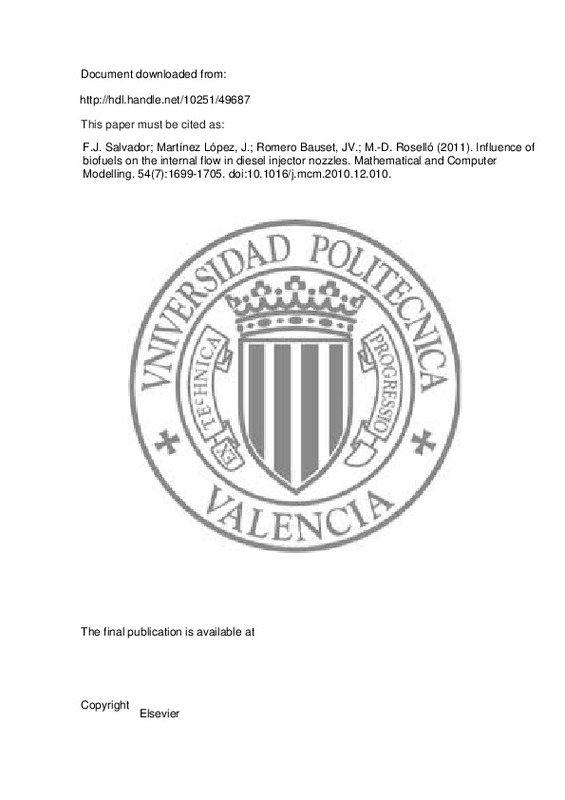Salvador Rubio, FJ.; Hoyas, S.; Novella Rosa, R.; Martínez López, J. (2011). Numerical simulation and extended validation of two-phase compressible flow in diesel injector nozzles. PROCEEDINGS OF THE INSTITUTION OF MECHANICAL ENGINEERS PART D-JOURNAL OF AU. 225:545-563. https://doi.org/10.1177/09544070JAUTO1569
Por favor, use este identificador para citar o enlazar este ítem: http://hdl.handle.net/10251/28865
|
Título:
|
Numerical simulation and extended validation of two-phase compressible flow in diesel injector nozzles
|
|
Autor:
|

 Salvador Rubio, Francisco Javier
Salvador Rubio, Francisco Javier

 Hoyas, S
Hoyas, S

 Novella Rosa, Ricardo
Martínez López, Jorge
Novella Rosa, Ricardo
Martínez López, Jorge
|
|
Entidad UPV:
|
Universitat Politècnica de València. Departamento de Máquinas y Motores Térmicos - Departament de Màquines i Motors Tèrmics
|
|
Fecha difusión:
|
|
|
Resumen:
|
In this paper, the ability of a computational fluid dynamics code to reproduce cavitation phenomena accurately is checked by comparing data acquired by numerical simulations against those obtained from different experiments ...[+]
In this paper, the ability of a computational fluid dynamics code to reproduce cavitation phenomena accurately is checked by comparing data acquired by numerical simulations against those obtained from different experiments involving the mass flow, the momentum flux, and the effective injection velocity. Cavitation is modelled using a single-phase cavitation model based on a barotropic equation of state together with a homogeneous equilibrium assumption. In the research reported in this paper, the ability to use the code for actual diesel injector nozzle geometries and conditions has been checked and validated. The main contribution of the present investigation and what makes it different from previous work in the literature is the consideration of extended experimental data for validation purposes: the mass flow, the momentum flux at the nozzle exit, and the effective injection velocity. These are unique features in contrast with other publications, which normally take into account at the most, if at all, the cavitation morphology or the mass flow. The results obtained and their comparison with available experimental data show how the model is able to predict the behaviour of the fluid in such conditions with a high level of confidence. © 2011 Authors.
[-]
|
|
Palabras clave:
|
Cavitation
,
Diesel injector
,
Internal flow
,
Nozzle
,
Barotropic equation
,
Cavitation model
,
Computational Fluid Dynamics codes
,
Diesel injector nozzles
,
Diesel injectors
,
Experimental data
,
Injection velocity
,
Internal flows
,
Mass flow
,
Momentum flux
,
Nozzle exits
,
Numerical simulation
,
Unique features
,
Computational fluid dynamics
,
Computer simulation
,
Equations of state
,
Mass transfer
,
Momentum
,
Non Newtonian liquids
,
Nozzles
,
Jet pumps
,
OpenFOAM
|
|
Derechos de uso:
|
Cerrado |
|
Fuente:
|
PROCEEDINGS OF THE INSTITUTION OF MECHANICAL ENGINEERS PART D-JOURNAL OF AU. (issn:
0954-4070
)
|
|
DOI:
|
10.1177/09544070JAUTO1569
|
|
Editorial:
|
Professional Engineering Publishing
|
|
Versión del editor:
|
http://pid.sagepub.com/content/225/4/545.full.pdf+html
|
|
Código del Proyecto:
|
info:eu-repo/grantAgreement/GVA//GV%2F2009%2F031/
|
|
Agradecimientos:
|
This work was partly sponsored by Generalitat Valenciana in the framework of Project GV/2009/031 'Estudio del flujo en el interior de toberas de inyeccion diesel'. This support is gratefully acknowledged by the authors. ...[+]
This work was partly sponsored by Generalitat Valenciana in the framework of Project GV/2009/031 'Estudio del flujo en el interior de toberas de inyeccion diesel'. This support is gratefully acknowledged by the authors. The authors would also like to thank the Universidad de Valencia for the computer resources, technical expertise, and assistance provided in the use of the supercomputer Tirant.
[-]
|
|
Tipo:
|
Artículo
|






![[Cerrado]](/themes/UPV/images/candado.png)




